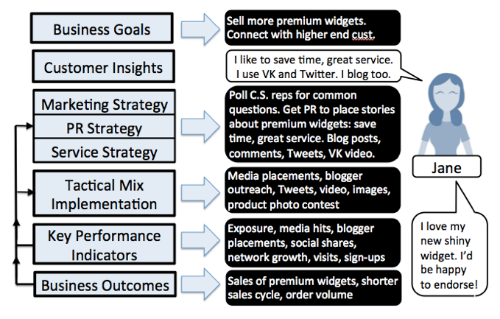 Most marketers “get” that services like Facebook, Google and media are where customers can be attracted and engaged. They use email marketing and advertising to promote offers to convert and life is good.
Most marketers “get” that services like Facebook, Google and media are where customers can be attracted and engaged. They use email marketing and advertising to promote offers to convert and life is good.
At least that’s how it used to be.
The reality is that customers are becoming more complex, requiring more points of contact and information as they move through the sales cycle. Companies offering up single, direct channel promotions are finding it increasingly difficult to compete.
This is why I’m such a big advocate of taking a customer-centric view and then integrating tactics so brands can become the most logical solution when and where it matters most to buyers.
One of the most important things about having been involved in the search marketing world for a long time is the idea of identifying what’s in demand and being that thing at the moment of customer need (ZMOT). When a customer needs to solve a problem, they search Google or Bing and there you are; leading the pack in the search results – just waiting to be clicked so you can deliver your offer to a qualified customer.
Search isn’t the singular home run channel it used to be
My SEO background is where the idea of “being the best answer” comes from. But today, search isn’t the singular home run channel it used to be. Customers have other prominent influences and means for discovering information and numerous device types to consume and interact with media. Considering all those factors, planning for the best answer strategy can seem a bit tricky.
The answer is an integrated marketing approach. One of the slides I used on this topic at a recent social media workshop earned a bit more attention than the others. Maybe it was because the slide is so awesome it captured their focused attention? Or maybe it was because the slide is overloaded with text and arrows and the audience was simply perplexed?
I’m inclined to lean toward the latter, so to provide an example of how a marketer might connect the dots between goals and conversions with an integrated approach, I’ll use this post to explain my Frankengraphic:

The Scenario – We have done our homework to understand a specific customer segment. We know their common demographic, psychographic and behavioral characteristics. Or at least simple data points like reasons for buying, preferred information discovery channels, content consumption preferences (media type, device, topic) and the kinds of offers and CTAs that work.
Through understanding our target customer goals, pain points and preferences, we can develop an integrated content marketing plan that is optimized for findability, engagement and action.
Business Goals – Marketing is accountable for creating demand for increasing revenue and many other variations that add to the business bottom line. Some of those are increased brand awareness, increase in sales volume, frequency and a decrease in duration of sales cycle, lowered marketing costs.
In the graphic above, we’re focused on selling more of a premium product to a target audience that represents a higher end buyer characterized as “Jane”.
Customer Insights – To be meaningful with a premium product or service offer to Jane, we need to understand her situation as a buyer on the high end of the spectrum. What causes her to need this kind of product? What situations often exist around the purchase? What factual and emotional triggers are involved with Jane’s buying experience? What questions does Jane have through the sales cycle?
Collecting buyer information from existing customers, web analytics, social media monitoring and your front line staff (Customer Service, Sales) that interact with customers on a daily basis can help inform which of your customers are “Jane”. From that data we can create a buyer persona that will inform our marketing approach, tactics and measurement.
In this highly abbreviated example, Jane cares most (buying triggers) about saving time and great service. She uses a regional social network, Twitter and she also blogs. Our task is to become “the best answer” where it matters and on topics that are most relevant to Jane’s reason for buying premium “widgets”.
Marketing, PR, Customer Service Strategy – The way companies are structured, (and agencies too), marketing operates in a silo with few interactions across other departments. Convergence is happening, but it’s going to take some time.
In the case of Jane, our integrated approach would be designed to create a brand narrative across channels that support the interests of premium customers with particular focus on topics around saving time and providing stellar service. Being present in a meaningful way on multiple media: owned, earned, paid and shared provides a congruent experience across channels.
Tactical Mix and Implementation – Our tactical mix might start by drawing on existing customer surveys and data as well as drawing insights from Customer Service to identify those key topics and concerns premium customers like the Janes have. We’d make sure we create information in the places where Jane discovers, consumes and acts on information online.
Along with posting to our own blog, and social network channels, our content plan would call for working with Public Relations to secure media placements in industry publications and blogs with the kind of information that will connect Jane to our offer. Awareness, Interest, Consideration and ultimately, Purchase.
Coordination with social media channels like Twitter and other relevant social networks in support of media coverage, blogging and ads provide a congruent set of messages about how our premium widgets save time like no other and come with first class service – the things Jane cares about most.
Key Performance Indicators – Our integrated strategy calls for themed content published across owned, earned, paid and shared media, so KPIs that track our content’s reach and engagement would be the focus. Any measurement effort needs to start with benchmarks of course. Social network size, current engagement on the target topics, search visibility, owned media content consumption of target topics – essentially both on and off site indications.
If we want to be known as a premium brand that saves time and provides first class service, then we’d need to establish the current share of voice and search for our brand and those topics. Then continue to monitor our marketing efforts to increase positive mentions and affinity of our brand in connection with how we want to be known to the Jane customer segment.
Web analytics, SEO tracking and social media monitoring services will provide KPI reporting. Brought into a dashboard, these KPIs will be the pulse of our progress towards reaching and engaging with Jane.
Business Outcomes – By increasing the number of credible mentions of our brand as “the best answer” in the context of a premium solution across multiple channels and media types, our hypothesis is that the Jane customer segment will discover, consume and act our information, pulling themselves through most of the sales cycle.
Growth in overall premium brand affinity on social and industry media as well as leads, sales, revenue and customer acquisition through premium widget sales would all be viable business outcomes as a result of a successful “best answer” marketing program.
Optimize Performance – Using KPI and business outcome data, we can refine our messaging, channel participation, media outreach and offers to continuously improve the performance of our program. Whether it’s to improve reach, engagement or conversions – optimization is the core of any ongoing marketing program, especially one that is integrated across multiple channels and media types.
When you look beyond the standard sales cycle of Awareness, Interest, Consideration and Purchase you can find that your content marketing, SEO and social media efforts will bear even more productive fruit in the form of referrals and brand advocacy. A big part of effective optimization is about making it easy for your target audience to do what you want them to do. So make it easy for customers, prospects, the media and network influencers to find, consume and act on your content.
Be present where it matters. Be the best answer for whatever it is that your customers care about most, relevant to your brand’s solutions.
Hopefully this simplified view of an integrated effort across media types to “be the best answer” is helpful to you and will inspire you to create more meaningful customer experiences that increase revenue and grow your brand.
Are you implementing multichannel, integrated marketing programs? What obstacles or successes have you experienced?
Top image: Shutterstock


